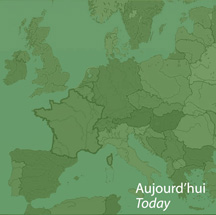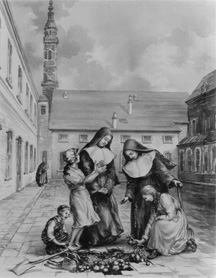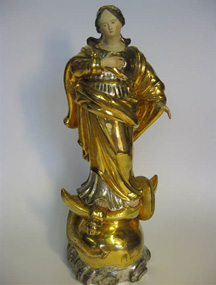The fundamental calling of Mère Julie is Christian education, especially for poor children.
Julie founds the first schools in Amiens, Saint-Nicolas, Namur, Montdidier, Rubempré and Jumet, which were all in France, since Belgium did not yet exist.
In Amiens, people did not approve of Julie’s travels. However, in Namur she is supported by Monsignor Pisani de la Gaude, the Bishop of Namur who encourages her to make foundations where it is possible.
 She travels many kilometers in search of suitable houses where the sisters and pupils will be welcome. In 1809, she is at Saint-Hubert ; in 1810, she makes a foundation at Nouveau Bois in Ghent, and in 1811, Zele is established.
She travels many kilometers in search of suitable houses where the sisters and pupils will be welcome. In 1809, she is at Saint-Hubert ; in 1810, she makes a foundation at Nouveau Bois in Ghent, and in 1811, Zele is established.
In spite of the war during the last years of Napoleon’s regime, Julie continues to open schools in Andenne, Gembloux and Fleurus.
Let’s not forget that, at the time, no rapid means of communication existed. When returning from her travels, Mère Julie finds many letters from her daughters, especially from superiors of the secondary houses. It is necessary to guide them, to support them, to console them; not being able to be in several places at once, she sends frequent, long letters, which take her time.
Gifted with a practical sense, Julie gives advice on keeping house. Her letters show us a person full of humor and with a limitless patience, always in a good mood. By means of these personality traits, she renders holiness attractive and accessible to all. In her letters, Julie insists on the solid formation of her sisters and on the way in which they should be taught. Some words return ceaselessly : “Ah! How good is the Good God!”
After 22 years of paralysis, Julie is cured in a miraculous manner, and in the space of 10 years, she undertakes more than 120 trips. Julie crosses France and Belgium, in a stagecoach, on a donkey or, often, even on foot.

See, on right, a map of France in 1800. The boundaries are not the same as today (as on the map immediately following).
In 1804, Julie founds the Congregation in an enlarged France. With the victory of the French at the Battle of Fleurus in 1794, the Austrian Netherlands and the Principality of Liège (present-day Belgium) were annexed to France, for the next 20 years.
 The map was redrawn in 1815 after the Battle of Waterloo: the Belgians are united to the Dutch in the Kingdom of the Netherlands. In 1830 Mother St. Joseph experienced the independence of Belgium.
The map was redrawn in 1815 after the Battle of Waterloo: the Belgians are united to the Dutch in the Kingdom of the Netherlands. In 1830 Mother St. Joseph experienced the independence of Belgium.
Houses Founded by Julie
1. Amiens (1804) 2. Saint-Nicolas (1806) 3. Montdidier (1807) 4. Namur (1807) 5. Jumet (1808) 6. Rubempré (1808) 7. Saint-Hubert (1809) 8. Gand (1810) 9. Zele (1811) 10. Raineville (1812) 11. Andenne (1813) 12. Gembloux (1813) 13. Fleurus (1814)

2. Saint-Nicolas: In her Memoirs, Françoise tells of the origin of the sisters’ habit. In 1806 habits were made of plain black woolen material, long cloaks that reached almost to the ground; the headdress was a sort of black bonnet, also of wool - Julie had brought the pattern to Flanders. The wimple was of white linen. The Bishop of Ghent, Msgr. Fallot de Beaumont, blessed this first religious habit.
 3. Montdidier: “As Julie and another sister left Plessier, near Montdidier, they came face to face with a mad dog, which had already bitten a great number of persons. The Sister was terrified, but Julie said to her: “Do not be afraid, daughter, God is with us”, and when the animal had come close up to her, she said to it very sweetly and gently: “Let us pass, my friend; we are the little servants of the Lord, and are going to do His work.” Then the dog became quiet for a space, and allowed them to pass without doing them any harm; after which it was rabid and dangerous as before."
3. Montdidier: “As Julie and another sister left Plessier, near Montdidier, they came face to face with a mad dog, which had already bitten a great number of persons. The Sister was terrified, but Julie said to her: “Do not be afraid, daughter, God is with us”, and when the animal had come close up to her, she said to it very sweetly and gently: “Let us pass, my friend; we are the little servants of the Lord, and are going to do His work.” Then the dog became quiet for a space, and allowed them to pass without doing them any harm; after which it was rabid and dangerous as before."
5. Jumet: On June 16, 1815, after the battle of Ligny, marauding soldiers who were looking for food attacked the convent and broke down the front door. The children had been hidden in the basement to shield them from the army rabble. A worker at the convent provided food for the hungry soldiers, who then went on their way. The deputy mayor then sent a guard to the convent to spare the sisters from any similar incident.
7. Saint-Hubert: On August, 1810, Julie, unable to find transport to Namur, decides to walk the 60 kilometers. On the road, she meets two soldiers who are also walking to Namur. Since they were evidently good men, Julie thinks it better to accompany them rather than travel alone. It is very hot. As the Memoirs of Mother St. Joseph relates it, Julie hears the Captain say: "I would give the last drop of my blood for my Emperor (Napoléon)!" "And I," Julie murmurs, "should I not give all to my God?” Julie arrives in Namur exhausted and hungry. She has eaten only an egg and a little bread on this long walk!
 8. Gand: Driven by poverty and lack of provisions, the community of Sisters in Nouveau Bois decided to plant a plot of potatoes. Anyone who experienced war-time rationing can appreciate this “back to the land” bias. Probably Julie could have, too, except for one thing: the spot chosen for the operation. The Sisters used a paved yard where the children played. With immense exertion they took up stones and planted potatoes. The potatoes were shooting up most satisfactorily when Julie arrived one day on a visit. Delightedly, the Sisters showed off the promising crop. But Julie was definitely not impressed: “What have you done?” she asked the Superior. “I know you are poor. But are you no longer going to reckon on God’s Providence? Must the good Sisters and children be deprived of air and space when already their food is insufficient? Come, we must undo all this. Send for your little pupils. Give them an hour extra play and let them jump and dance on this ill-advised field of yours. Then the sisters can replace the paving.”
8. Gand: Driven by poverty and lack of provisions, the community of Sisters in Nouveau Bois decided to plant a plot of potatoes. Anyone who experienced war-time rationing can appreciate this “back to the land” bias. Probably Julie could have, too, except for one thing: the spot chosen for the operation. The Sisters used a paved yard where the children played. With immense exertion they took up stones and planted potatoes. The potatoes were shooting up most satisfactorily when Julie arrived one day on a visit. Delightedly, the Sisters showed off the promising crop. But Julie was definitely not impressed: “What have you done?” she asked the Superior. “I know you are poor. But are you no longer going to reckon on God’s Providence? Must the good Sisters and children be deprived of air and space when already their food is insufficient? Come, we must undo all this. Send for your little pupils. Give them an hour extra play and let them jump and dance on this ill-advised field of yours. Then the sisters can replace the paving.”
 12. Gembloux: Painting of The Sorrowful Christ, venerated at the church at Gembloux before which Mother Julie used to stop to pray when she entered this church.
12. Gembloux: Painting of The Sorrowful Christ, venerated at the church at Gembloux before which Mother Julie used to stop to pray when she entered this church.
13. Fleurus: In 1815, after Napoleon’s defeat at the battle of Waterloo, soldiers are wandering in the towns and countryside in search of provisions. A band of soldiers invade the convent at Fleurus (one of the towns closest to the battlefield). Panicked, the sisters take refuge upstairs. The soldiers run up the stairs but stop suddenly at the statue of the virgin on the staircase.
